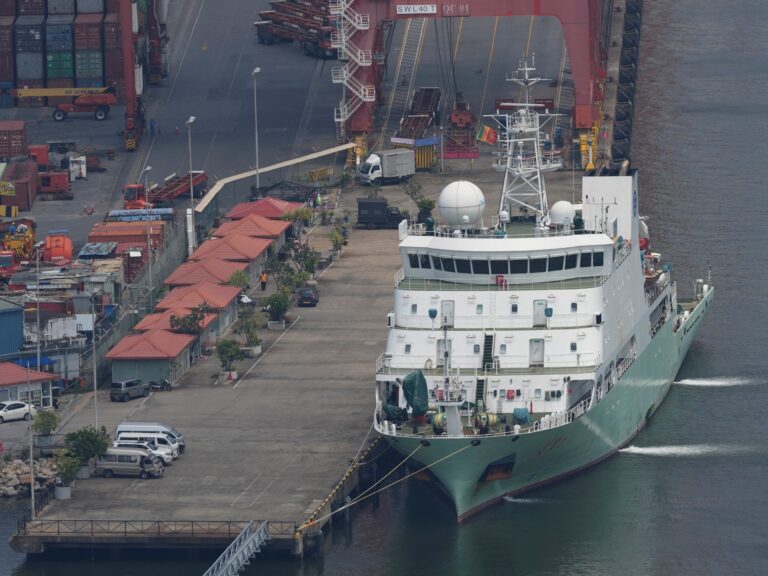India is desperate to secure exploration rights for a cobalt-rich underwater mountain in the middle of the Indian Ocean, but its bid faces competing claims with Sri Lanka also seeking to mine the precious mineral in the region.
The urgency of India’s application stems from concerns about China’s presence in the Indian Ocean, with the world’s second-largest economy already dominating the global cobalt supply chain, Indian officials and analysts told Al Jazeera.
Cobalt is a critical mineral used widely in electric vehicles and batteries and is seen as a key element in the transition to green energy.
India approached the Jamaica-based International Seabed Authority in January seeking permission to explore the cobalt-rich Afanasy Nikitin Seamount, located in the central Indian Ocean, east of the Maldives and about 1,350 kilometers (850 miles) off the Indian coast. Established in 1994, the International Seabed Authority is an autonomous international organization empowered by the United Nations Convention on the Law of the Sea to regulate economic activity on the seabed.
India has also paid a fee of $500,000 to the ISA to consider its application, which outlines its desire to carry out extensive geophysical, geological, biological, oceanographic and environmental studies in the proposed seamount over a 15-year period. The seamount consists of 150 blocks spread over 3,000 square kilometers (1,158 square miles).
But as ISA assessed India’s application, it discovered that Afanasy Nikitin Seamount lies entirely within an area that another country also claims as being within its continental shelf boundaries, according to a memo the agency shared with Al Jazeera. ISA did not name that other country in its response to India, but experts believe the seabed authority was referring to Sri Lanka. A country’s continental shelf is the edge of its landmass that lies below sea level.
According to a memo shared with Al Jazeera by the ISA, the seabed authority had sought India’s response to its determination that the claims are competing, but on March 12, India said it could not respond until its opinion had been considered by the 29th Legal and Technical Committee, which is deliberating the ISA’s application.
As a result, the ISA notice said India’s application had been put “on hold.” Once India responds, the ISA will review the application again.
Sri Lankan claims
A country’s continental shelf typically extends 200 nautical miles (370 km) from its coast and defines an exclusive economic zone which is available only to that country for economic purposes, although ships of other countries may pass through it unimpeded.
However, coastal states can appeal to the United Nations Commission on the Limits of the Continental Shelf (CLCS) to argue that the outer limits of their continental shelf exceed 200 nautical miles.
Sri Lanka did just that in 2009, applying to extend the limit of its continental shelf from 200 nautical miles to a much wider area. The CLCS has yet to rule on Sri Lanka’s claim, but if accepted, the Afanasy Nikitin Seamount would fall within Sri Lanka’s maritime boundary.
The CLCS, which is tasked with examining states’ claims regarding the extension of their continental shelf boundaries, has accepted such requests in the past. For example, Pakistan, Australia and Norway have rights to maritime areas beyond 200 nautical miles from their coasts.
In 2010, India responded to Sri Lanka’s complaint with the CLCS without challenging the small neighbour’s claim. But in 2022, India changed its position, claiming that Sri Lanka’s claim prejudices Indian interests. India has asked the commission to “consider and not qualify” Sri Lanka’s complaint.
Al Jazeera reached out to the Indian and Sri Lankan governments for comment on the conflicting claims but did not receive a response.
China’s presence
But analysts say Sri Lanka is not New Delhi’s biggest concern.
A senior maritime law expert said India’s move appeared to be driven by a desire to establish a foothold in the region to deter China’s presence, rather than any direct exploratory objectives.
“India’s argument is not to start exploration immediately but to establish its presence and interests before China gets involved,” said a maritime expert now a senior official in the Indian judiciary, speaking on condition of anonymity due to his position.
According to the ISA, China, Germany and South Korea currently have contracts for deep-sea exploration in various parts of the Indian Ocean.
Nikhileth Nedumugatunmar, assistant professor of maritime law at the Ambedkar University of Law in Chennai, India, said India’s claim to the ISA is strong because the Afanasy Nikitin Seamount is located far from any country’s exclusive economic zone. “India has the right to seek exploration permission from the ISA,” he told Al Jazeera.
What is at stake?
KV Thomas, a former scientist at the National Centre for Geosciences in Thiruvananthapuram, India, agreed with the official’s assessment that China was a key factor in India’s decision.
Thomas said India’s deep-sea mining plans are still in their early stages, but the country has demonstrated its ambitions in recent years.
In 2021, the company launched the Deep Ocean Mission, allocating $500 million over five years to explore deep-sea resources.
In 2023, the Indian government announced that it was developing a manned deep-sea mining submersible to “exploratory mine for polymetallic nodules from the seafloor” as part of its Deep Ocean Mission. Polymetallic nodules, also known as manganese nodules, are rock nodules that are an important source of important minerals such as cobalt.
China currently controls 70 percent of the world’s cobalt and 60 percent of lithium and manganese (among other critical minerals), according to the International Renewable Energy Agency, but India, which has a deadline to reach net-zero emissions by 2070, needs access to these minerals to power its clean-energy economy.

